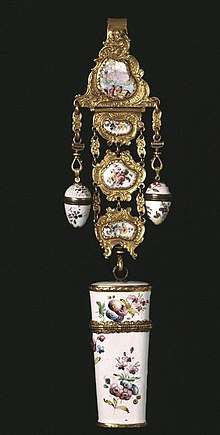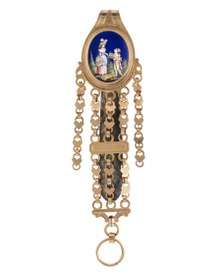Chatelaine (chain)
A chatelaine is a decorative belt hook or clasp worn at the waist with a series of chains suspended from it. Each chain is mounted with useful household appendages such as scissors, thimbles, watches, keys, vinaigrette, and household seals.[1]


Ancient Roman women wore chatelaines with ear scoops, nail cleaners, and tweezers.[2] Women in Roman Britain wore 'chatelaine brooches' from which toilet sets were suspended.[3]
The remnants of chatelaines and chatelaine bags have been found in the graves of females in the seventh and eighth century in the United Kingdom. Often found with the chatelaine artifacts would be wire rings, beads, buckles, knives and tools.[4]
Chatelaine bags refer to bags suspended from a waistband by cord or chain, which were popular from the 1860s to the end of the 19th century.[5]
Chatelaines were worn by many housekeepers in the 19th century[6] and in the 16th century Dutch Republic, where they were typically used as watch chains for the most wealthy. Similar jewelry was also worn by Anglo-Saxon women, as seen from the burial record, but their function is uncertain.
The name chatelaine derives from the French term châtelaine which meant the mistress of a chateau. She would have worn a belt for her keys, which the current meaning of chatelaine derives from [7].
Status among women
The chatelaine was also used as a woman's keychain in the 19th century to show the status of women in a household. The woman with the keys to all the many desks, chest of drawers, food hampers, pantries, storage containers, and many other locked cabinets was "the woman of the household". As such, she was the one who would direct the servants, housemaids, cooks and delivery servicemen and would open or lock the access to the valuables of the house, possessing total authority over who had access to what. Frequently, this hostess was the senior woman of the house. When a woman married and moved into her father-in-law's house, her husband's mother would usually hold on to the keys. However, if the mother became a widow, the keys and their responsibilities and status were often passed to the oldest son's wife. Younger women and daughters in the house often wanted the appearance of this responsibility, and would often wear decorative chatelaines with a variety of small objects in the place of keys, especially bright and glittering objects that could be used to start a conversation.[8] In the case of the absence of a woman of the house, the controller of the keys was often a hired housekeeper.
References
- "Chatelaine." Antique jewelry glossary. Adin antique jewelry. Accessed 29 Sept. 2012.
- D'Ambra, Eve (2007). Roman Women. Cambridge University Press. pp. 116–17. ISBN 978-0-521-81839-1.
- Allason-Jones, Lindsay, ed. (2011). Artefacts in Roman Britain. Cambridge University Press. p. 204.
- Williams, Howard (2006). Death and Memory in Early Medieval Britain. Cambridge University Press. pp. 73. ISBN 978-0521142250.
- Victoria and Albert Museum, Natalie Rothstein, Madeleine Ginsburg, Avril Hart, Valerie D. Mendes, and Philip Barnard. 1984. Four hundred years of fashion. London: Victoria and Albert Museum in association with W. Collins. Page 174.
- "Chatelaines". 1Earth Antiques Appraisals. Web. Accessed 29 Sept. 2012.
- Chatelaine Miriam Webster Online Dictionary. Accessed 28 June 2020
- Smith, Albert, Paul Gavarni, and John Gilbert. The Natural History of the Flirt. London: D. Bogue, 1848.
External links
| Wikimedia Commons has media related to Chatelaines. |

- . Encyclopædia Britannica. 5 (11th ed.). 1911.
- 18th Century Chatelaines